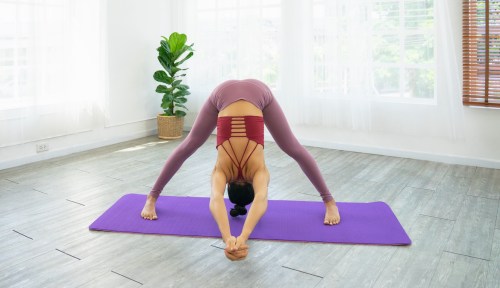If You’re Stressed, Try Flipping Your Perspective Upside Down—Literally
Explore a new perspective with inversion yoga, which can help you destress, get grounded, and build strength.

When you’re dealing with a stressful situation, sometimes the best course of action is to try to change your perspective. For example, while you can’t control the actions of other people, you can control your own . One way to enforce that self-focused perspective change—literally—is to practice inversion yoga.
Experts in This Article
co-founder of Sky Ting Yoga in New York City
co-founder of Sky Ting Yoga in New York City.
Mara Olney is a yoga teacher and founder and CEO of LÜM Health Studio.
run coach and founder of the Movement &
yoga teacher and founder of S3 Yoga
Nike Master Trainer, yoga instructor, and fitness model
“It’s so nice when you’re experiencing anxiety and stress to flip yourself upside down, but also to fold forward” says Krissy Jones, the co-founder of Sky Ting Yoga, in a calming yoga for stress relief flow that’s part of this month’s Well+Good Trainer of the Month Club series. As Sky Ting co-founder Chloe Kernaghan demonstrates a forward fold in the video, Jones calls attention to what the pose is actually doing for Kernaghan on a spacial and energetic level: “You’ll notice Chloe is more internal. She’s looking at herself. She can’t see what’s going on around her. Her head’s reaching towards the floor, and she’s moving in towards a hibernation position, like a shelled position.”
Grounding in your own body and breath isn’t the only reason inversion yoga offers stress relief, among other benefits. Here’s why you should consider flipping upside down in your next practice.
What is a yoga inversion?
Thought of yoga inversions might conjure handstands or headstands. But actually, anytime your head faces the floor counts as an inversion, too.
“Inversions don’t always necessarily mean going upside down,” yoga instructor Traci Copeland explains in a “yoga inversions for beginners” video practice. “You can also do a classical inversion like downward dog or forward fold, or straddle forward fold, or even something as simple as legs up the wall.”
The hallmark of the inversion is that your blood is flowing downward to your brain instead of up. “Your spine is rounded, your hips are lifted, and you can lean a little bit side to side or roll around on the crown of the head—just stimulating the top of the head onto the floor, getting some blood flow to the brain,” Jones says.
The benefits of inversion yoga
It can calm the nervous system
Stress activates the sympathetic nervous system, which may rev up your heart rate or even make you feel unsafe. Yoga teachers say flipping upside down is one way to help your body move out of that fight-or-flight mode (though more research is needed to declare a causal relationship, scientifically speaking).
“Forward folds stretch and create space between the vertebrae in the spine, which is the commander of our autonomic nervous system,” Savanna Stevens, founder of S3 Yoga, previously told Well+Good about the benefits of forward folds. “This system directly affects our response to stress, so folds in yoga are really soothing to the nervous system, mind, and body.”
Yoga teacher Mara Olney agreed, and explained that yoga instructors will often include forward folds at the end of class before savasana for this reason. “When you’re looking for a calming and grounding experience in your yoga practice, forward folds are where you want to dedicate more time,” Olney says. “Just like how heart-opening poses energize your nervous system, forward folding postures create a calming effect throughout your central nervous system.”
Check out this calming 20-minute yoga flow featuring several inversions if you want to see the effects for yourself.
It can help build muscle
Muscles can adjust to new challenges a lot faster than you might think, which is typically why a progressive overload method is what trainers often recommend for building muscle. But another way to build strength is to change up the types of movements you’re doing, which is where inversions come in.
“[Inverting] mixes up the regular muscle memory and puts your body in a new position,” trainer Meg Takacs previously told Well+Good about building strength. “Anytime you do that, you’re going to confuse your muscle memory and test new ways to move.”
It can improve your balance (and strengthen stabilizer muscles)
Balance is linked to longevity and injury prevention, and one of the best ways to improve balance is to strengthen the stabilizer muscles that surround your spine and other joints. Inversions that require core strength are a great way to target these muscles.
“You’re handling your own bodyweight more because you are at more of an inverted angle, which requires you to stabilize and balance more weight,” Takacs says.
Copeland agrees. “It’s a great way to improve circulation, better balance, but it’s also a great way to work on core strength,” she says.
It is highly accessible
Inversions don’t need to be advanced or require extreme strength. Doing a yoga inversion like a forward fold or legs up the wall is something many yogis can incorporate into their practice.
“What I love most about forward folds and its variations is that they are simple and accessible,” Olney says. “Whether you practice yoga regularly or not, [you can] add forward folds into your daily life to calm your mind.”
Sign Up for Our Daily Newsletter
Get all the latest in wellness, trends, food, fitness, beauty, and more delivered right to your inbox.
Got it, you've been added to our email list.










